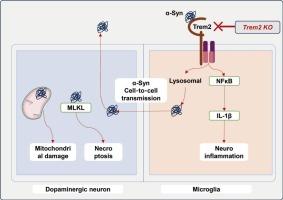TREM2 mediates parkinsonism-like neurodegeneration in carbon disulfide-induced neurotoxicity
IF 2.8
3区 医学
Q2 NEUROSCIENCES
引用次数: 0
Abstract
Parkinson’s disease (PD) is a neurodegenerative disorder characterized by progressive loss of dopaminergic neurons and aggregation of α-Synuclein (α-Syn). While both genetic and environmental factors are implicated in PD pathogenesis, the mechanisms underlying neurodegeneration induced by environmental toxins and associated genetic responses remain largely unknown. Recently, triggering receptor expressed on myeloid cells 2 (TREM2) has been proven to be a critical mediator of toxin-induced motor neuron degeneration. Using GWAS data, this study employed Mendelian randomization analysis and revealed a significant association between elevated serum TREM2 levels and increased risk of secondary PD. Further experiments used 20 male wild-type mice and 20 male TREM2 KO mice exposed to corn oil or carbon disulfide (an environmental toxin associated with PD), respectively, revealed that TREM2 acts as a molecular switch, amplifying environmental neurotoxicity through the excessive activation of microglia. In contrast, Trem2 KO exhibited pronounced neuroprotective effects, including reduced α-Syn aggregation in the substantia nigra, alleviated nigral neuronal structural damage, diminished neuroinflammation, and improved motor coordination in mice. Finally, protein docking and interaction analysis verified that TREM2 recognizes α-Syn and participates in PD-related pathological events, including neuroinflammation and mitochondrial damage. In summary, the present study identifies TREM2 as a pivotal mediator in environmentally induced Parkinsonian syndromes, providing novel insights into the mechanisms underlying neurodegeneration due to environmental toxin exposure and offering potential targets for precise therapeutic interventions.

TREM2介导二硫化碳诱导的神经毒性帕金森样神经变性
帕金森病(PD)是一种以多巴胺能神经元进行性丧失和α-突触核蛋白(α-Syn)聚集为特征的神经退行性疾病。虽然遗传和环境因素都与帕金森病的发病机制有关,但环境毒素诱导神经退行性变的机制和相关的遗传反应在很大程度上仍然未知。近年来,骨髓细胞上表达的触发受体2 (TREM2)已被证明是毒素诱导的运动神经元变性的重要介质。本研究使用GWAS数据,采用孟德尔随机化分析,发现血清TREM2水平升高与继发性PD风险增加之间存在显著关联。进一步的实验将20只雄性野生型小鼠和20只雄性TREM2 KO小鼠分别暴露于玉米油或二硫化碳(一种与PD相关的环境毒素)中,发现TREM2作为一种分子开关,通过过度激活小胶质细胞来放大环境神经毒性。相比之下,Trem2 KO表现出明显的神经保护作用,包括减少黑质α-Syn聚集,减轻神经神经元结构损伤,减轻神经炎症,改善小鼠运动协调。最后,通过蛋白对接和相互作用分析证实TREM2识别α-Syn并参与pd相关的病理事件,包括神经炎症和线粒体损伤。总之,本研究确定TREM2是环境诱导的帕金森综合征的关键介质,为环境毒素暴露导致的神经退行性变的机制提供了新的见解,并为精确的治疗干预提供了潜在的靶点。
本文章由计算机程序翻译,如有差异,请以英文原文为准。
求助全文
约1分钟内获得全文
求助全文
来源期刊

Neuroscience
医学-神经科学
CiteScore
6.20
自引率
0.00%
发文量
394
审稿时长
52 days
期刊介绍:
Neuroscience publishes papers describing the results of original research on any aspect of the scientific study of the nervous system. Any paper, however short, will be considered for publication provided that it reports significant, new and carefully confirmed findings with full experimental details.
 求助内容:
求助内容: 应助结果提醒方式:
应助结果提醒方式:


